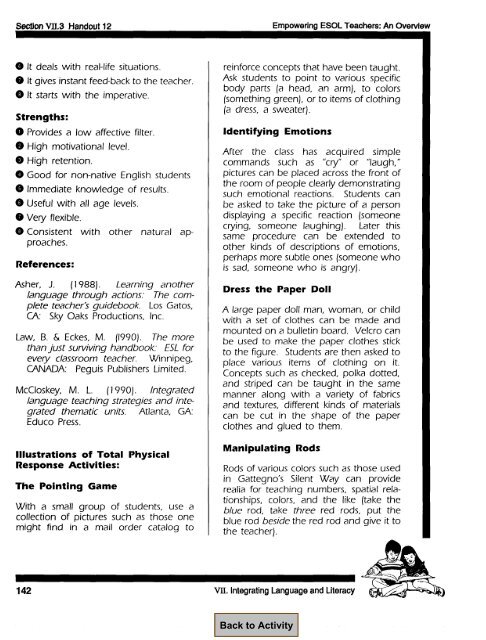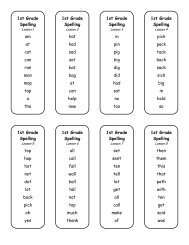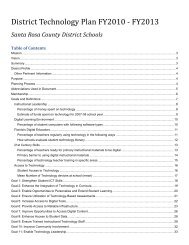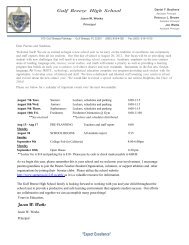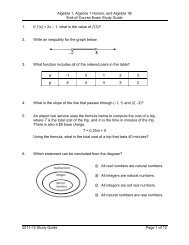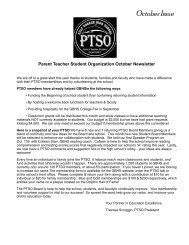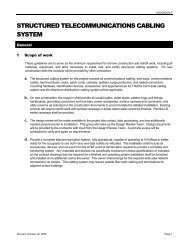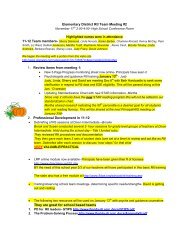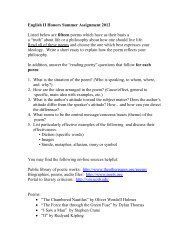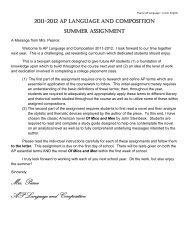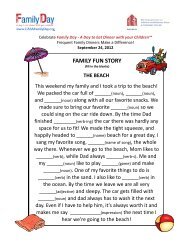Total Physical Response (TPR) (VII HO12)
Total Physical Response (TPR) (VII HO12)
Total Physical Response (TPR) (VII HO12)
Create successful ePaper yourself
Turn your PDF publications into a flip-book with our unique Google optimized e-Paper software.
Section <strong>VII</strong>-3 Handout 12 Em~owerina ESOL Teachers: An Overview<br />
@ It deals with<br />
real-life situations.<br />
@ It gives instant feed-back to the teacher.<br />
~ k starts with the imperative.<br />
Strengths:<br />
O Provides a low affective filter.<br />
~ High motivational level.<br />
0 High retention.<br />
@ Good for non-native English students<br />
@ Immediate knowledge of results.<br />
~ Useful with all age levels.<br />
0 Very flexible.<br />
~ Consistent with other natural approaches.<br />
References:<br />
Asher, J. (1988). Learning another<br />
language through actions: The complete<br />
teacher> guidebook. Los Gates,<br />
CA: Sky Oaks Productions, Inc.<br />
Law, B. & Eckes, M. (1990). The more<br />
than just surviving handbook. E5L for<br />
every c/assroom teacher. Winnipeg,<br />
CANADA: Peguis Publishers Limited.<br />
McCloskey, M. L. (1990j. Integrated<br />
language teaching strategies and inte<br />
grated thematic units. Atlanta, GA:<br />
Educo Press.<br />
Illustrations of <strong>Total</strong> <strong>Physical</strong><br />
<strong>Response</strong> Activities:<br />
The Pointing<br />
Game<br />
With a small group of students, use a<br />
collection of pictures such as those one<br />
might find in a mail order catalog to<br />
reinforce concepts that have been taught.<br />
Ask students to point to various specific<br />
body parts (a head, an arm), to colors<br />
(something green~, or to items of clothing<br />
(a dress, a sweater).<br />
Identifying<br />
Emotions<br />
After the class has acquired simple<br />
commands such as “cry” or “laugh,”<br />
pictures can be placed across the front of<br />
the room of people clearly demonstrating<br />
such emotional reactions. Students can<br />
be asked to take the picture of a person<br />
displaying a specific reaction (someone<br />
crying, someone laughing). Later this<br />
same procedure can be extended to<br />
other kinds of descriptions of emotions,<br />
perhaps more subtle ones [someone who<br />
is sad, someone who is angry).<br />
Dress the Paper Doll<br />
A large paper doll man, woman, or child<br />
with a set of clothes can be made and<br />
mounted on a bulletin board. Velcro can<br />
be used to make the paper clothes stick<br />
to the figure. Students are then asked to<br />
place various items of clothing on it.<br />
Concepts such as checked, polka dotted,<br />
and striped can be taught in the same<br />
manner along with a variety of fabrics<br />
and textures, different kinds of materials<br />
can be cut in the shape of the paper<br />
clothes and glued to them.<br />
Manipulating<br />
Rods<br />
Rods of various colors such as those used<br />
in Gattegno’s Silent Way can provide<br />
realia for teaching numbers, spatial relationships,<br />
colors, and the like (take the<br />
b/ue rod, take three red rods, put the<br />
blue rod beside the red rod and give it to<br />
the teacher].<br />
142 <strong>VII</strong>.Integrating Language and Literacy


